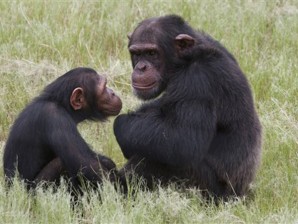Conservationist: Reasons for chimp attack unclear
JOHANNESBURG — In the six years he’s managed a sanctuary for abused and orphaned chimpanzees, South African conservationist Eugene Cussons is from time to time called on to comment when an ape somewhere in the world attacks a human. Cussons says he always could pinpoint a moment of taunting or perceived aggression that could have set off the quick and powerful animals.

In this photo taken Feb. 1, 2011, chimpanzees sit in an enclosure at the Chimp Eden rehabilitation center, near Nelspruit, South Africa. The international institute founded by primatologist Jane Goodall opened the sanctuary in 2005. It is a home to chimpanzees rescued from further north in Africa, where they are hunted for their meat of held captive as pets. AP/Erin Conway-Smith
This time, though, the attack was at his own Jane Goodall Institute Chimpanzee Eden in South Africa. And Cussons, host of the Animal Planet show “Escape to Chimp Eden,” is without an explanation.
In telephone interview Saturday, Cussons said he would have to wait until the severely injured victim, a University of Texas at San Antonio graduate student inspired by famed primatologist Jane Goodall to study chimps, was well enough to provide details about Thursday’s attack.
It was the first such attack since Cussons, working with Goodall’s renowned international institute, converted part of his family’s game farm into the sanctuary in 2006.
“You can train for it, you can do your best to prepare,” Cussons said. “But when it actually happens, it’s shocking and traumatic for everyone.”
Cussons’s team quickly evacuated the dozen tourists to whom Andrew F. Oberle had been giving a lecture and tried to separate the chimps from Oberle. In the end, Cussons, who was himself attacked by a chimp as he tried to pull it off Oberle, took the extreme step of firing into the air, scaring the animals away.
Article continues after this advertisementOberle was bitten repeatedly and dragged for nearly a kilometer (half mile). Cussons said one of the chimps was injured in the scuffle, and he was awaiting a veterinarian’s report to determine the nature and extent of the injury. No one else was hurt.
Article continues after this advertisementMale chimps can stand up to 1.7 meters (5 feet, 7 inches) tall and weigh about 70 kilograms (154 pounds), according to the Jane Goodall institute. The two chimps that attacked Oberle were male, though the sanctuary’s website did not say how large the animals were.
Cussons said it was the first time he had asked Oberle to speak to visitors. The student had arrived last month for a follow-up visit after an extended stay to observe the chimps a year or so ago, Cussons said. As a researcher, Cussons said Oberle had been trained to ensure he understood how the animals might behave and knew to keep a safe distance. Cussons said Oberle was given additional training before addressing the tour group.
Cussons said Oberle broke the rules by going through the first of two fences that separate humans from the chimps. The chimps then grabbed him and pulled him under the second fence, which is electrified. Cussons said it was unclear why Oberle had moved so dangerously close.
Mediclinic Nelspruit hospital said Saturday that the 26-year-old Oberle remained in critical condition in intensive care. Oberle underwent surgery at the hospital Thursday.
Oberle’s uncle, Carl Oberle, told The Associated Press on Saturday that Oberle’s parents were on their way to South Africa.
“It is a hard time right now for our family,” said Carl Oberle, who did not want to discuss details of his nephew’s condition.
He said his nephew had returned to South Africa to study the animals that were his “passion.” He noted the young man previously worked for several years as a camp counselor at the St. Louis Zoo.
“He was a real inspiration to the children he worked with and extremely well-liked and respected,” zoo spokeswoman Susan Gallagher said Saturday.
Oberle’s mother, Mary Flint, said Friday that her son knew the risks of working with chimps and would not want them blamed for the attack.
“He adored them,” she said. “Since he was a little boy he just loved them, and I just have faith that … when all is said and done, he’s going to go right back into it.”
The sanctuary has been closed to tourists since the attack, while government and police officials investigate. The Jane Goodall Institute South Africa is conducting its own investigation.
“Everyone at Chimp Eden is hurting,” Cussons said, saying the thoughts of staff members were with Oberle and his family.
Cussons said the two chimps that attacked Oberle, Amadeus and Nikki, had been isolated since the attack. He said they were calm and exhibiting remorse, which he said chimps show by behaving submissively.
Human-animal contact is kept to a minimum at the sanctuary, designed as a haven for chimpanzees that have been rescued from elsewhere in Africa. Some lost their parents to poachers in countries where they are hunted for their meat or to be sold as pets, and others were held in captivity in cruel conditions.
According to the sanctuary’s website, one of the chimps involved in the attack, Amadeus, was orphaned in Angola and brought to South Africa in 1996, where he was kept at the Johannesburg Zoo until the sanctuary opened. The other, Nikki, came from Liberia in 1996 and also was held at the zoo until becoming one of the first chimps at the sanctuary. Before arriving in South Africa, Nikki, whose parents were killed for their meat, had been treated like a son by his owners, who dressed him in clothes, shaved his body and taught him to eat at a table using cutlery, the website said.
___
Associated Press writer Heather Hollingsworth contributed to this report from Kansas City, Missouri.